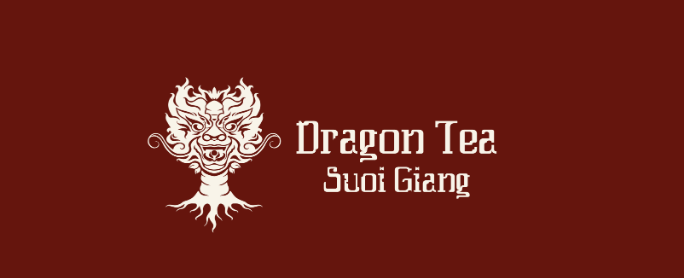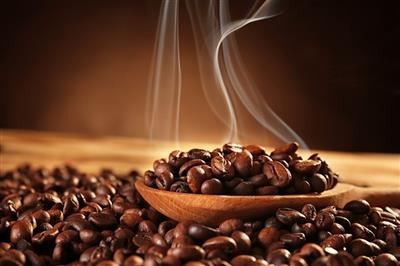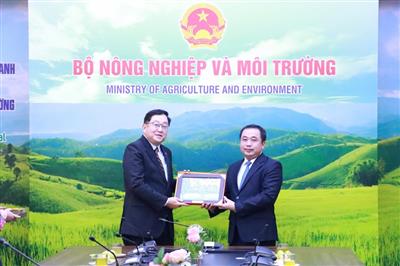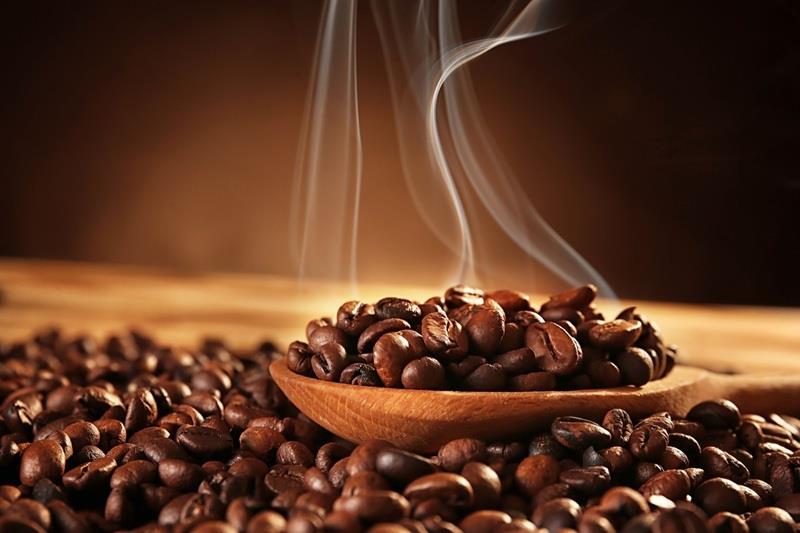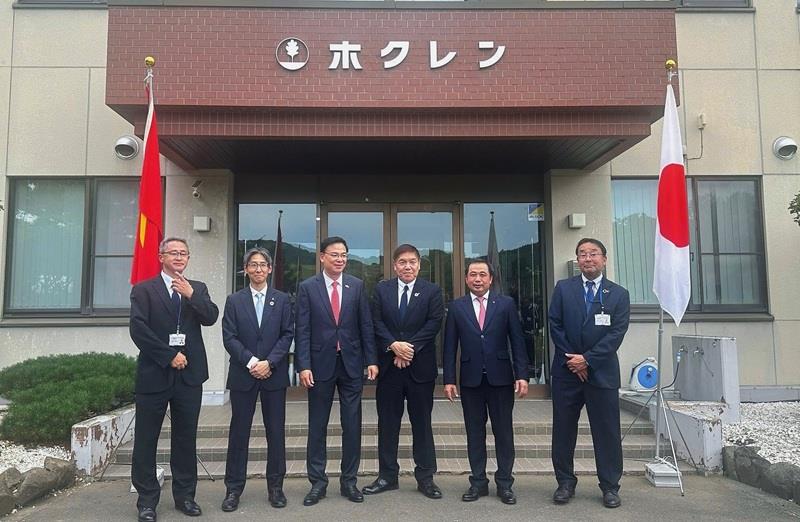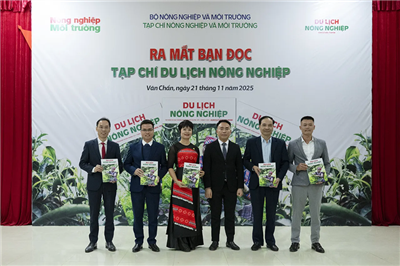
Transforming aquaculture sludge into organic fertilizer: A new path for sustainable agriculture
29/09/2025TN&MTFrom what is often considered a valueless by-product, sludge generated from seafood processing plants and shrimp ponds, a research team comprising Nguyen Thi Bach Kim, Le Hoang Viet, and Nguyen Vo Chau Ngan (Can Tho University) has demonstrated its potential as a feedstock for organic fertilizer production. Analytical results indicate that seafood processing sludge (SPS) possesses more favorable characteristics for composting compared to shrimp pond sludge (ShPS), thereby opening new opportunities for circular agriculture.

Utilizing aquaculture sludge offers dual benefits, reducing pollution and improving soil fertility, while advancing Vietnam’s shift toward circular agriculture and green growth
Aquaculture: A key economic sector and the challenge of waste
Vietnam plays an increasingly significant role in the global seafood market. “In 2024, seafood exports reached USD 10 billion, a 12% increase from 2023. Processed shrimp alone contributed USD 3.9 billion (up 14%) thanks to 737,000 hectares of brackish-water shrimp farming, 622,000 hectares of black tiger shrimp and 115,000 hectares of whiteleg shrimp, with total output of 1,264,300 tons” (VASEP, 2025a; 2025b). These figures underline the achievements of a strategic economic sector, but they also reveal the magnitude of environmental challenges, as waste generation rises in parallel with production expansion.
The environmental footprint is considerable. “Shrimp pond effluents contained 37,929 tons of total nitrogen (TN) and 4,678 tons of total phosphorus (TP) in 2024, while pond sludge accumulated 10,620.12 tons of TN and 7,459.37 tons of TP. Processing activities discharged only about 0.14% of the wastewater volume compared with farming, yet with extremely high pollutant loads: TSS 1,190 mg/L, TN 197 mg/L, TP 24 mg/L, and total Coliform 430,000 MPN/100 ml.” Most pond sludge in the Mekong Delta is still discharged directly into canals, posing risks of disease transmission and water contamination (Phong, 2024).
Current sludge management practices remain fragmented. The study notes: “At industrial wastewater treatment plants, sludge is typically managed by methods such as dewatering or sun-drying for application to ornamental trees, on-site composting, sale to microbial fertilizer producers, or transfer to contracted disposal units. However, landfilling remains widespread in Vietnam, leading to significant environmental concerns” (Phuong, 2023). At the same time, “aquaculture sludge contains considerable nutrients that can potentially be harnessed for organic fertilizer production.” This dual reality underscores both the challenge and the urgency of converting an environmental burden into a resource for sustainable farming.
Seafood processing sludge and shrimp pond sludge: Contrasting feedstocks
The research team collected SPS samples from the Tra Noc Industrial Park (Can Tho) and ShPS samples from shrimp ponds in Vinh Chau (Soc Trang). Samples were analyzed for physical, chemical, and heavy metal properties and benchmarked against Vietnamese standards QCVN 50:2013/BTNMT and QCVN 01-189:2019/BNNPTNT to assess suitability for organic fertilizer.
The findings show SPS has clear advantages. With a pH of 7.06 and an electrical conductivity (EC) of 0.583 mS/cm, SPS lies within a safe range that supports microbial activity during composting. Its total nitrogen (TN) content reaches 4.65% (dry weight), sufficient to meet minimum requirements for organic fertilizer. Heavy metal analysis confirmed that “arsenic (As) and mercury (Hg) were not detected above the method detection limits (As LOD = 2.5 mg/kg; Hg LOD = 2.0 mg/kg), while lead (Pb) and cadmium (Cd) remained within safe limits”—Pb at 2.29 mg/kg and Cd at 0.48 mg/kg. This suggests SPS does not pose secondary contamination risks when used as a composting material, though continued monitoring is advisable.
By contrast, ShPS shows significant limitations. Nutrient indicators are consistently low: total carbon (TC), TN only 0.31–0.38%, TP 0.05–0.06%, and available potassium (AK, as K₂O) 0.04–0.06%—all below standard requirements. Moreover, ShPS exhibits high salinity (1,000–1,200 mg/L), which inhibits microbial activity and slows decomposition. Its total solids (TS) also decline during cultivation (from 232.56 g/L to 179.72 g/L), weakening compost structure and impairing aeration. These factors make ShPS unsuitable as a primary feedstock, requiring blending with carbon-rich or low-salinity materials such as rice straw, biochar, or zeolite to balance its deficiencies.
The comparison highlights a stark contrast: SPS emerges as a promising input for organic fertilizer, while ShPS can only serve as a secondary component in composting mixtures. The authors emphasize this conclusion: SPS has the potential to be a reliable feedstock, whereas ShPS demands substantial technical interventions before practical application.
Barriers to overcome
Despite its promise, SPS faces technical hurdles. The analysis revealed that “moisture content of SPS reached 90.6%, well above the optimal range of 50–70% for aerobic composting.” Excessive moisture encourages anaerobic decomposition, odor generation, and nitrogen loss. Furthermore, the C/N ratio of 6.26 is far below the recommended minimum (≥12, ideally 25–30), leading to carbon deficiency for microbial metabolism. As such, the study stresses the need to blend SPS with carbonaceous bulking agents like rice straw, husks, or dry crop residues to adjust the C/N ratio and improve porosity.
Conversely, ShPS faces the opposite set of issues. “The C/N ratio of ShPS was 19.8–26.9, within the suitable range for microbial activity.” However, ShPS lacks nearly all essential nutrients: TN 0.31–0.38%, TP 0.05–0.06%, AK 0.04–0.06%—far below the required 1–8%. This means ShPS cannot serve as a primary input and must be supplemented with nitrogen, phosphorus, and potassium. Its salinity of 1,000–1,200 mg/L further inhibits microbial function, necessitating desalinization measures such as freshwater rinsing, co-composting with low-salinity feedstocks, or zeolite addition.
Implications and prospects for application
The research clearly concludes: “Seafood processing sludge (SPS) has greater potential for organic fertilizer production than shrimp pond sludge (ShPS).” With its higher nutrient content, suitable pH and EC, As and Hg below detection limits, and other heavy metals within safe limits, SPS can serve as a valuable raw material if properly processed. Co-composting SPS with carbon-rich residues can correct its nutrient imbalance, reduce excessive moisture, and produce a low-cost, safe organic fertilizer capable of partially replacing chemical fertilizers. This offers farmers a cost-effective alternative while reducing reliance on imports.
According to the authors, utilizing aquaculture sludge generates a dual benefit: reducing environmental pollution and enhancing soil fertility. Moreover, it aligns with global trends toward circular agriculture and green economy development. In the Vietnamese context, where national strategies target emission reduction, organic farming, and sustainable growth, this approach transforms waste into a resource, addressing both environmental and agricultural challenges. In other words, converting sludge into fertilizer is not only an immediate solution to waste management but also a long-term pathway for Vietnam’s aquaculture and agriculture to pursue green growth.
Ngoc Huyen
Source: Proceedings of the 2nd National Scientific Conference on “Agricultural and Rural Environment and Sustainable Development"

